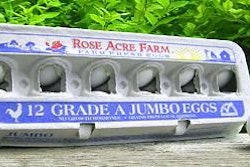.jpg?auto=format%2Ccompress&q=70&w=400)
In 1982 he began working for the Midwest United Egg Producers' (UEP) Regional Cooperative, then transferred to the National UEP office in Atlanta in 1992. In 2007 he became president of UEP upon the retirement of Al Pope.
Egg Industry is fortunate to have been able to discuss current issues with Gene at a time when he is involved in serious issues including the emerging lawsuits and Proposition 2 in California, instigated by the Humane Society of the United States (HSUS). He consented to this interview on Sept. 30.
Egg Industry: What lead to the formation of United Egg Producers as a national organization for the U.S. industry?
Gene Gregory: Prior to 1998 there were five regional cooperatives which were effectively serving their constituencies. Consolidation and maturity occurring within the industry involving the emergence of large integrations operating across many states, and all of us facing similar problems, required concentration of resources and coordination in a central office.
EI: What have been the major achievements of UEP over the past twenty years?
GG: One was probably the introduction of the UEP Five-Star Program to prevent SE (Salmonella enteritidis). It came at a time when the industry needed to quickly implement quality assurance food safety programs to address consumers' concerns. Although there were a number of successful state programs such as the Pennsylvania EQAP (Egg Quality Assurance Programs), it was felt that the industry required a single standard for producers in states that had yet to develop their own programs.
The UEP was instrumental in working with the American Egg Board (AEB) which was responsible for education of both consumers and the institutional market. The AEB also worked with U.S. Department of Agriculture which developed and promoted the "Fight Bac" program which was also beneficial in promoting safe storage, handling and preparation of eggs.
Working with the Food and Drug Administration (FDA) we were able to establish refrigeration requirements from the point of processing through transportation which also contributed to safety. The UEP is still actively involved with the FDA in developing the Salmonella Reduction Initiative.
EI: What has been the contribution of UEP to welfare of flocks?
GG: Following trends in Europe, the UEP recognized the need for proactive action on welfare. We were concerned that European Union mandates were based on emotion and ethical principles but there was little scientific evidence to support the regulations which were being framed.
The UEP approached Professor Jeffrey Armstrong of Purdue University in 1998 to establish a scientific committee which he selected independently of UEP. The Committee met with leading primary breeders, equipment manufacturers and visited egg farms.
After two years of literature review and deliberations, the Scientific Welfare Panel produced a series of recommendations directly related to caged hens. The Producer Committee of the UEP accepted their guidelines although there were still unresolved questions relating to feeding space and molting. These provisional guidelines were incorporated into a program for certification of producers.
EI: How is the program implemented?
GG: Originally, UEP thought that a limited number of members would adopt the certification program. In the end it turned out that over 80% of egg producers subscribed to the provisions of the program.
In order to avoid market disruptions and to ensure an adequate supply of eggs to satisfy market demand, UEP met with the Food Marketing Institute and the National Council of Chain Restaurants. These industry associations agreed to a phase-in of the program over a six-year period. This allowed producers to either re-cage their facilities or to build new housing to supply the market as density was decreased.
EI: How has the UEP welfare program developed since inception?
GG: The approach to molting was resolved following publication of directed research which showed that alternatives to molting by starvation were both practical and, in fact, beneficial. After the studies were validated and a recommendation obtained from the Scientific Welfare Panel, the Producers Committee acted by amending the program to mandate flock-friendly molting practices which have now been universally adopted by producers certified by the program.
There is still concern over feed trough space allowance and studies are in progress to address this issue. It is emphasized that the UEP welfare program is based on science and that all requirements are derived from the results of controlled experiments subjected to peer review by competent scientists.
EI: The UEP Welfare Program of 2002 and subsequent amendments dealt with caged-hens. What is the situation with regard to floor-housed flocks?
GG: The Scientific Welfare Panel has been working for a number of years on the issue of floor-housed flocks. Again applying scientific principles, the panel developed a series of standards adopted by the Producers Committee and issued them at the beginning of this year.
EI: How do you view the future of egg production?
GG: There will be more consolidation, dictated in part by the need to achieve efficiency and driven by the realities of high feed and fuel costs. I believe that the industry will become more environmentally friendly and that we will have to improve manure handling.
We must obtain greater value from our by-products. This presumes greater use of on-belt manure drying and composting both in-house and in dedicated facilities.
EI: What developments do you envisage in marketing?
GG: I would hope that with maturity of the industry it will be possible to supply markets without the traditional swings between over- and under-production. It is my opinion that we will see growth in non-caged flocks but there are signs that price resistance is affecting the expansion in both cage-free and the organic segments of the industry.
I believe that the U.S. industry will continue to process a little more than 30% of production but I do not concur with some industry leaders who feel that breaking, pasteurization and added-value processing will attain significant growth as a proportion of total eggs produced.
EI: Price discovery, production statistics and trend forecasting are critical to making investment decisions. How is UEP addressing this need?
GG: To date we have been fortunate in relying on the diligence and wisdom of Don Bell of California who has assembled and issued statistics and generated forecasts based on his experience in the application of mathematical models.
The UEP is very interested in the establishment of a research unit at Iowa State University, staffed by an experienced agricultural economist to assume responsibilities for statistical reporting and forecasting following the retirement of Don Bell.
EI: In retrospect is there anything that you would have done differently based on your experience with UEP programs?
GG: I believe we should have concentrated more on education of consumers with our welfare program. We should also have enhanced our messages to consumers regarding how eggs are produced and their value, complimenting the work done by the AEB. We are actively addressing these issues using our website and through our public relations advisors.


















